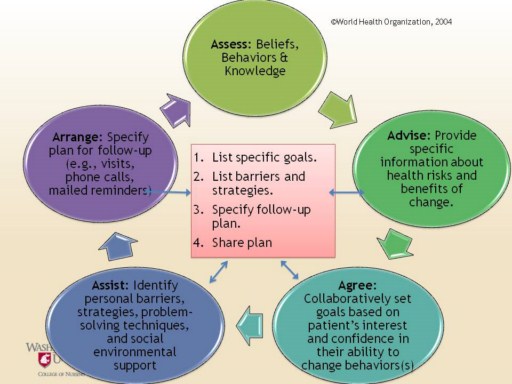| front |1 |2 |3 |4 |5 |6 |7 |8 |9 |10 |11 |12 |13 |14 |15 |16 |17 |18 |19 |20 |21 |22 |23 |review |
 |
The 5A’s can be used by any health care team member and in all types of health care settings.
During each stage of the process the following steps are recommended:
ASSESS:
•Review
goals that the patient has or that have been set previously.
•Evaluate
both levels of behavior and how the patient
feels
about the behavior he or she is trying to implement
•Ask
what the patient wants to discuss
ADVISE:
•Communicate
that what the patient
does
is as important as medication
•Provide
short statements with specific recommendations
•Link
recommendations to the patient’s views, risks, symptoms etc to make them
relevant
•Ask
what the patient thnks about the recommendation
•
AGREE:
•Ask
the patient what he or she most wants to work on
•Ask
the patient what he or she thinks would be a reasonable goal
•Use
questions and comments to help patient’s focus and be specific; the
patient should set a goal they want to work on NOT a goal the provider
thinks they should work on
•
ASSIST:
•Ask
the patient what he or she sees as the greatest challenges to achieving
the goal
•Ask
what he or she has done in the past to overcome obstacles
•Create
a written action plan for the patient to refer to….be aware of low
literacy, many patients will need simple wording and some will need an
action plan with pictures instead of words
•Include
supports and resources to help with the goal
•
ARRANGE (Follow-up):
•Set
a specific time for the next contact
•Tell
the patient you want and need to hear how they are doing
•Begin
the next contact with a review of progress on the goal or goals
•Follow-up
on the patient’s experience with any referrals to community resources.
Research on the implementation of the 5A’s to facilitate self-management suggests 4 keys to success:
1.Employ
all 5A’s during each interaction with the patient.
2.Use
open-ended questions to enhance patient centeredness.
3.Use
the 5A’s in conjunction with proactive care and follow-up
4.Document
the deliver of the 5A’s and provide the patient with written or, in the
case of low literacy patients, diagrammatic copies of the action plan.
●
As previously stated, the 5A’s provide guidelines to facilitate many of the self-management support concepts recommended in the Institute for Health Improvement’s toolkit. Community resources may also help patients and family members successful engage in self-management.
●
Reference: World Health Organization (2004). Self-management support for chronic conditions using 5A’s. Available at: http://www.who.int/diabetesactiononline/about/WHO 5A ppt.pdf |